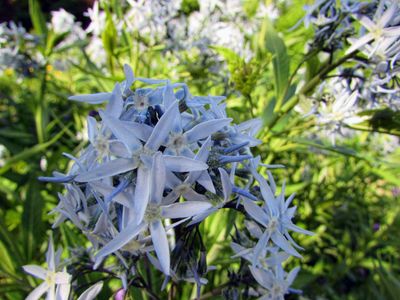Amsonia Propagation Methods
Amsonia propagation can be done by seed or division. However, seed germination can be slow and irregular and not all varieties of amsonia will produce replicas of the parent plant when propagated by seed. If you have a certain variety of amsonia which you want more of, propagation from division can ensure clones of the parent plant.
Propagating Amsonia Seeds
Like many perennials, amsonia seeds require a cool period or stratification in order to germinate. In the wild, amsonia plants release seed in late summer and autumn. These seeds then go dormant in garden debris, mulch, or soil under a blanket of snow, with winter providing the ideal cool period. In late winter to early spring when soil temperatures range steadily between 30-40 F. (-1 to 4 C.), amsonia germination begins. Mimicking this natural process will help make amsonia seed propagation more successful. Plant amsonia seeds in seed trays an inch (2.5 cm.) apart, lightly covering each seed with loose potting mix. Chill planted seed trays for several weeks in temperatures of 30-40 F (1-4 C). After stratifying the seeds for at least three weeks, you can slowly acclimate them to warmer temperatures. Amsonia seeds can take up to 10 weeks to sprout and young seedlings may not be ready for transplant for 20 weeks.
Dividing Amsonia Perennials
Propagating amsonia by divisions is a quicker and easier method to enjoy the instant beauty of adding more amsonia to the garden. Mature amsonia plants have woody stems and root structures. In flowerbeds that are given fresh compost, mulch, etc. each year, it is common for fallen or buried amsonia stems to take root. This natural propagation of a sister plant, right next to the original plant is known as layering. These amsonia off-shoots can be severed from the parent plant easily with a sharp, clean garden shovel and transplanted into new beds. Old, raggedy amsonia plants can be given new vigor by being dug up and divided in spring or fall. This benefits the plant by stimulating new growth above and below the soil level, while also gifting you with new amsonia plants for the garden. Simply dig up the large woody root ball with a clean, sharp garden shovel, and remove as much dirt as you can. Then cut apart the roots with a knife, hori hori or saw into transplantable sized sections which contain root, crown and stem of the new plants. To promote root growth, cut back the plant’s stems and foliage to about 6 inches (15 cm.) tall. These new amsonia plants can then be planted directly in the garden or planted in pots. When dividing plants, I always use a root stimulating fertilizer to reduce plant stress and ensure a healthy root structure.
